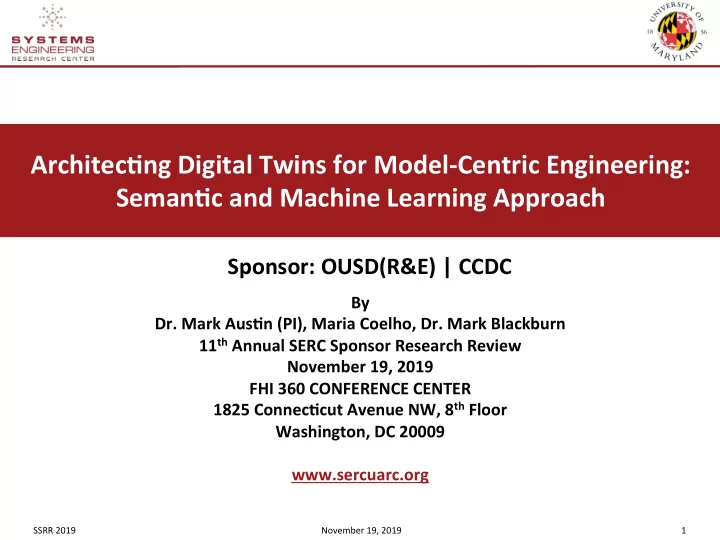

Architec(ng Digital Twins for Model-Centric Engineering: Seman(c and Machine Learning Approach Sponsor: OUSD(R&E) | CCDC By Dr. Mark Aus(n (PI), Maria Coelho, Dr. Mark Blackburn 11 th Annual SERC Sponsor Research Review November 19, 2019 FHI 360 CONFERENCE CENTER 1825 Connec(cut Avenue NW, 8 th Floor Washington, DC 20009 www.sercuarc.org SSRR 2019 November 19, 2019 1
Incubator Project Basic Idea: Explore design of digital twin architectures that support AI and ML formalisms working side-by-side as a team, providing complementary and supportive roles in collection of data, identification of events, and automated decision making. Military Drone (Physical) System Digital Twin (Cyber) DRONE OPERATING SYSTEM Knowledge Representation Semantic data Modeling Reasoning Learn Structure and Sequence Machine Identify Objects, Events actions Learning Remember Research Challenge: How to design digital twin elements and their interactions so that collectively they can support a wide variety of systems engineering methods and processes? Incubator Goals: Understand the range of possibilities for which machine learning of large-scale graphs and their attributes support activities in model-centric engineering. SSRR 2019 November 19, 2019 2
Architecture for Mul(-Domain Seman(c Modeling Step 1: Data-Ontology-Rule Footing (Work at UMD / NIST / SERC in 2017). Multi − domain Semantic Modeling design flow design flow 1 Domain Ontology classes Domain − Specific Rules and properties Data Models / Sources import visit Domain A Rules A Ontology A Data Source A import visit Domain B Rules B Ontology B Data Source B import import Executable Processing of Events Attach Events !!! Rules Engine Semantic Graph Revisions to semantic graph SSRR 2019 November 19, 2019 3
Mul(-Domain Seman(c Modeling Example: Detection and Diagnostic Analysis of Faults in HVAC Equipment. Framework for Concurrent Data − Driven Development of Domain Models, Ontologies and Rules design flow design flow Domain Ontology Classes Domain Data Models and Rules and Properties Sources of Data (XML data files) Engineering Engineering Engineering Building.rules Building.owl Building model Sensor.rules Sensor.owl Sensor model Equipment.rules Equipment.owl Equipment model FDD.rules FDD.owl visit FDD model Environment Environment Environment Weather.rules Weather.owl Weather model Occupant.rules Occupant.owl Occupant model load load Framework for Executable Processing of Events Meta − Domain Ontology & Rules load load Spatial.owl Reasoner Semantic Graphs ........... graph transformation Spatial.rules SSRR 2019 November 19, 2019 4
Mul(-Domain Seman(c Modeling Building Occupant FDD Equipment Domain Domain Domain Domain Rule 05: Valve is shut. AND F1 F2 F11 F12 F3 Rule 01: Occupant location. AND F4 F5 AND F6 F14 F13 F15 F7 Rule 02: Occupant expected comfort. AND AND F16 AND F8 F9 F17 F10 Rule 06: Coil failed. Rule 03: Occupant current comfort. Rule 04: A fault has occurred. AND F18 F19 Rule 07: AHU failed. AND F4 F20 Rule 08: Evidence 4 is true and, hence, Hypothesis 3 is valid. SSRR 2019 November 19, 2019 5
Combined Seman(cs + Data Mining Step 2: Work at UMD / Building Energy Group at NIST / NCI, 2018-2019 Multi − domain Semantic Modeling design flow design flow 1 Domain Ontology classes Domain − Specific Rules and properties Data Models / Sources import visit Domain A Rules A Ontology A Data Source A import visit Domain B Rules B Ontology B Data Source B domain domain refinement of refinement of ontologies data rules ontologies Machine Learning / Data Mining Semantic Feature Engineering 2 Classification Clustering Association decision tree Group A Group A implies Group B Group B Research Question: How can semantic modeling + machine learning / data mining work together as a team? SSRR 2019 November 19, 2019 6
Incubator Project Step 3: Focus on Machine Learning of Graphs and Model-Centric Engineering . Multi − domain Semantic Modeling Observation: A lot of model-centric design flow design flow 1 Domain Ontology classes Domain − Specific engineering boils down to representation Rules and properties Data Models / Sources of systems as graphs and sequences of import visit Domain A Rules A Ontology A Data Source A graph transformations punctuated by decision making and work / actions. import visit Domain B Rules B Ontology B Data Source B Hence: Explore opportunities for teaching domain domain refinement of refinement of machines to understand graphs. ontologies data rules ontologies Machine Learning / Data Mining Semantic Feature Engineering Input: System graph topology and attributes 2 Classification Clustering Association minimize decision tree Group A Group A loss implies Autoencoder Group B Group B compress encoder Predictions: graph nodes and labels, dependency lower − dimensional relationships. [ − 2.0, 0.5, 1.0 ..... − 0.5 ] Teaching Machines to Understand Graphs representation vector 3 decoder decompress Directed Undirected Weighted 5 8 1 4 2 Output: reconstruction of system graph SSRR 2019 November 19, 2019 7
Incubator Research Ques(ons • What types of graphs (e.g., undirected, directed, weighted, multi-graph) are easy for the ML to learn? • How well do these techniques work with graph topology and attributes that are dynamic? • What can the ML do that is outside the capability of semantic modeling? And vice-versa? • How can the ML improve the semantic modeling? And vice-versa? • How to design the red arrows connecting layers 1, 2 and 3? • How to represent and reason with uncertainties? • How does the difficulty of these challenges increase with graph size? • How to map AI-ML capability to state-of-the-art engineering views? Digital Twin (Cyber) Statechart View: Sequences of Digital Twin Control Actions ... Semantic Modeling Machine Learning Contact Information ......... Mark Austin (PI): austin@isr.umd.edu Maria Coelho: mecoelho@terpmail.umd.edu Mark Blackburn: mblackbu@stevens.edu SSRR 2019 November 19, 2019 8
Recommend
More recommend